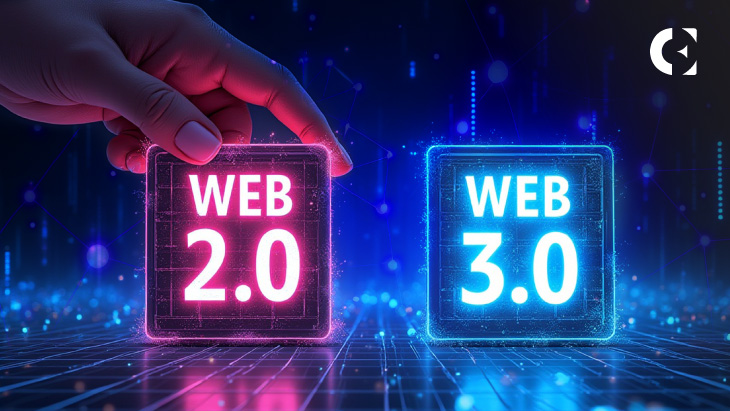The Internet has come a long way since its early days. What started as a collection of simple, static web pages has evolved into the rich, interactive, and social platforms we use daily. Now, we’re on the brink of another big shift, from Web2 to Web3, and it’s all about putting power back into the hands of users.
In Web2, we got social media, video sharing, and instant communication, however, it also gave major companies the power to access and sell our private information. Web3, by contrast, promises a more decentralized internet where users can own their data, control their digital identities, and actively participate in building value through blockchain and tokens. Understanding this difference is key to seeing why the internet’s future looks so different.
Table of contents
A Quick History of the Web
Web1: The “Read-Only” Web (1990s to Early 2000s)
Web1 is a digital library, wherein websites were simple and static, like basic HTML pages that only show information and are not of much use. People were mostly consumers, not creators. There were no social networks, no commenting, and very little interaction. This era was decentralized in the sense that many servers hosted websites independently, but content creation was limited to a select few, usually companies or skilled developers.
Web2: The Social and Interactive Web (2004 to Present)
With the evolution of Web2, anyone could create content, connect with others, and engage in real-time conversations. Social media platforms like Facebook, X, and YouTube exploded, empowering users to share photos, videos, and opinions instantly. Smartphones made the web personal and always accessible. But while users got tools to create and connect, major corporations took control behind the scenes. They owned the servers, controlled the data, and made money by collecting and selling user information through targeted advertising. This centralization sparked concerns about privacy, censorship, and monopolies, setting the stage for the next wave: Web3.
So, What is Web3?
Web3 or Web 3.0 is built on blockchain technology and decentralized networks that don’t rely on a single company or server. Instead, they give users control over their data and digital identities, using cryptographic wallets instead of usernames and passwords. Compared to Web2, where control is in the hands of others, Web3 gives you authority. With Web3, digital assets like cryptocurrencies, NFTs (non-fungible tokens), and tokens that represent ownership or voting rights live in your wallet. Further, it enables you to collaborate and govern through decentralized autonomous organizations (DAOs), decentralized finance (DeFi), where you can lend, trade, and earn interest without banks.
Why is Web3 Better than Web2?
Centralization vs Decentralization
Web2 relies on centralized platforms that control your data and infrastructure. For example, Facebook has access to all your private information, including phone number, location, and even photos or videos, whereas Web3 is decentralized. This implies that the network does not have a single authority owning the network. Here, data and applications run on blockchains and peer-to-peer protocols.
Data Ownership
In Web2, platforms control your data and can sell or restrict it at will, but in Web3, it lets you own your data directly through your wallet. This helps you to keep track of who accesses it and how it is being used.
Identity Management
Web2 uses usernames and passwords managed by platforms. In Web3, it uses cryptographic keys tied to your wallet, and this ‘self-sovereign identity” means that you can authenticate without needing a middleman.
Incentives and Rewards
Web2 platforms earn mostly from advertisements. They either run on the platform in a side panel or as a pop-up. Adverts are the major source of revenue for Web2, while in Web3, users can earn tokens for participating — creating content, providing liquidity, or governing networks, aligning incentives across the ecosystem.
Transparency and Open-Source
While Web2 algorithms and policies don’t provide adequate information, and are sometimes shady, Web3 projects tend to be open-source, with public blockchains where anyone can audit transactions and code.
Challenges Web3 Still Faces
Although Web3 is intriguing, users do face several challenges in this sphere. Here are some of the common obstacles faced:
User Experience
With new concepts like digital wallets, private keys, and gas fees introduced, it is quite difficult for users to comprehend the terms. However, decentralized applications have become easier to use now with user interfaces and onboarding processes, so that users need not possess deep technical knowledge to connect with them.
Security Concerns
Smart contracts are powerful but vulnerable to bugs and hacks. Scams, phishing, and rug pulls have played a significant role in damaging the development of Web3. Since the platform lacks a central authority, users bear the responsibility for their safety.
Regulatory Uncertainty
The constant crisis of regulatory conditions is a hurdle to users. With each jurisdiction having its own regulations, this creates uncertainty for projects and users alike.
Environmental Impact
Proof-of-Work blockchains like Bitcoin use a lot of energy, raising sustainability concerns. Newer consensus methods like Proof-of-Stake are greener, but public perception remains a challenge.
Why Web3 Matters
Despite these challenges, Web3 is more than just technology. Compared to Web2, Web3 gives power to users, enabling them to own their digital identities and assets. Further, decentralized finance offers access to financial services without banks, and NFTs create new ways to own and monetize digital art and collectibles. Further, DAOs enable communities to self-govern transparently. In a nutshell, Web3 becomes a shared space, where users have real control, than power-hungry major corporations.
Disclaimer: The information presented in this article is for informational and educational purposes only. The article does not constitute financial advice or advice of any kind. Coin Edition is not responsible for any losses incurred as a result of the utilization of content, products, or services mentioned. Readers are advised to exercise caution before taking any action related to the company.









